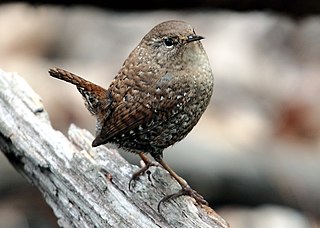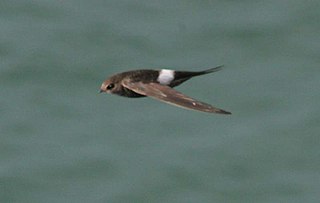
The winter wren is a very small North American bird and a member of the mainly New World wren family Troglodytidae. It was once lumped with Troglodytes pacificus of western North America and Troglodytes troglodytes of Eurasia under the name winter wren.

The tropical bottlenose whale, also known as the Indo-Pacific beaked whale and Longman's beaked whale, was considered to be the world's rarest cetacean until recently, but the spade-toothed whale now holds that position. As of 2010, the species is now known from nearly a dozen strandings and over 65 sightings.

The Pacific swift is a bird which breeds in eastern Asia. This swift is strongly migratory, spending the northern hemisphere's winter in Southeast Asia and Australia. The general shape and blackish plumage recall its relative, the common swift, from which it is distinguished by a white rump band and heavily marked underparts. The sexes are identical in appearance, although young birds can be identified by pale fringes to the wing feathers that are absent in adults. This swift's main call is a screech typical of its family. It is one of a group of closely related Asian swifts formerly regarded as one species.

The Pacific sleeper shark is a sleeper shark of the family Somniosidae, found in the North Pacific on continental shelves and slopes in Arctic and temperate waters between latitudes 70°N and 22°N, from the surface to 2,000 metres (6,600 ft) deep. Records from southern oceans are likely misidentifications of relatives. Its length is up to 4.4 m (14 ft), although it could possibly reach lengths in excess of 7 m (23 ft).

The Pacific gull is a very large gull, native to the coasts of Australia. It is moderately common between Carnarvon in the west, and Sydney in the east, although it has become scarce in some parts of the south-east, as a result of competition from the kelp gull, which has "self-introduced" since the 1940s.
The Proclamation of Neutrality was a formal announcement issued by U.S. President George Washington on April 22, 1793 that declared the nation neutral in the conflict between France and Great Britain. It threatened legal proceedings against any American providing assistance to any country at war.

Troglodytes is a genus of small passerine birds in the wren family. These wrens are around 11–13 centimetres (4.3–5.1 in) long. They are brownish above and somewhat paler below, with strong legs. Their short rounded wings and frequently cocked tail have a dark barred pattern. The flight is direct and buzzing.

Saint Pacificus of San Severino, born Carlo Antonio Divini, was an Italian Roman Catholic priest known for being a miracle-worker.

Somniosus is a widely distributed genus of deepwater dogfish sharks in the family Somniosidae. Several members of the genus are believed to attain lengths up to 7 m (23 ft), thus rank among the largest of sharks.

The Pacific shrew is a species of mammal in the family Soricidae. It is endemic to western Oregon in the United States. The Pacific Shrew is native to western Oregon, more specifically from the Siltcoos lake to the coast going from the border line of Douglas and Lane counties continuing south to the northern parts of California. The very first documented Pacific shrew to be caught was found at the mouth of the Umpqua River in 1858. They are normally found in damp areas along creeks in forests and sometimes near collapsed trees. Their refuge is of the utmost importance and they are seldom found far from it. This includes collapsed trees or dense vegetation. They use the flora to build a nest, gathering small plants such as grass, moss, lichen, or leaves into a pile and pushing themselves into the middle.

Ixodes pacificus, the Western black-legged tick, is a species of Ixodes, a parasitic tick found on the western coast of North America. It is the principal vector of Lyme Disease in that region.
Pogonocherini is a tribe of longhorn beetles of the Lamiinae subfamily.

Pristionchus pacificus is a species of free-living nematodes (roundworms) in the family Diplogastridae. The species has been established as a satellite model organism to Caenorhabditis elegans, with which it shared a common ancestor 200-300 million years ago. The genome of P. pacificus has been fully sequenced, which in combination with other tools for genetic analysis make this species a tractable model in the laboratory, especially for studies of developmental biology.
Ecyrus arcuatus is a species of beetle in the family Cerambycidae. It was described by Charles Joseph Gahan in 1892. It is known from Mexico, Honduras, Guatemala, and United States.
Ecyrus ciliatus is a species of beetle in the family Cerambycidae. It was described by Chemsak and Linsley in 1975. It is known from Mexico.
Ecyrus dasycerus is a species of beetle in the family Cerambycidae. It was described by Say in 1827.
Ecyrus hirtipes is a species of beetle in the family Cerambycidae. It was described by Charles Joseph Gahan in 1895. It is known from Guadeloupe, Barbados, Martinique, Cuba, Saint Vincent and the Grenadines, the Dominican Republic, Bahamas, Grenada, Haiti, and Puerto Rico. It feeds on Inga ingoides.
Ecyrus lineicollis is a species of beetle in the family Cerambycidae. It was described by Chemsak and Linsley in 1975. It is known from Mexico.
Zaplous annulatus is a species of beetle in the family Cerambycidae. It was described by Louis Alexandre Auguste Chevrolat in 1862, originally under the genus Ecyrus. It is known from Cuba and the United States.

The Pacific least gecko is a species of lizard in the family Sphaerodactylidae. It is endemic to Cocos Island.













